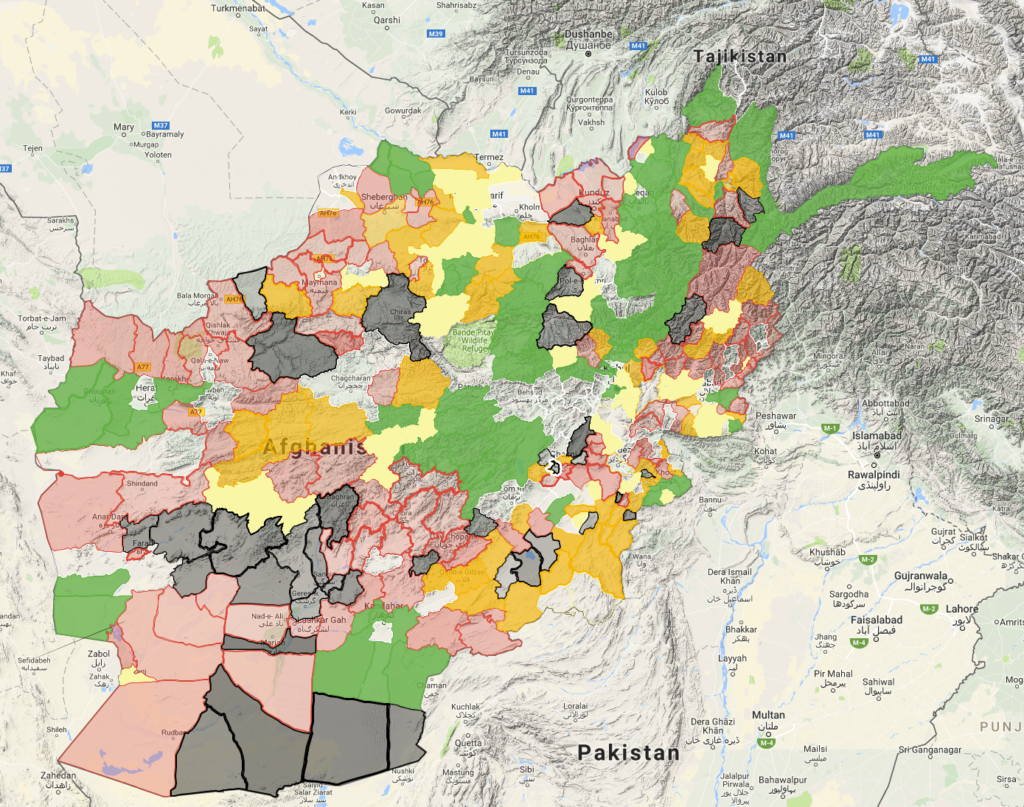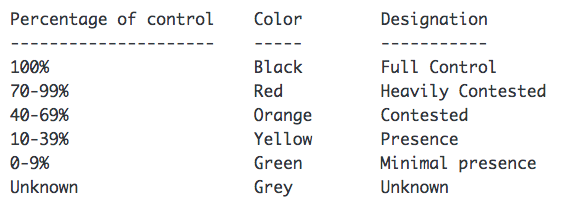The Taliban issued a “report” that attempts to determine areas in Afghanistan it controls as well as contested areas and areas under the influence of the Afghan government. While the report may be seen as propaganda to bolster its claims of controlling territory, it does not inflate or exaggerate the Taliban’s control of districts centers and contested areas throughout the country, compared to data compiled by FDD’s Long War Journal. The report was actually a rather conservative estimate, painting a dire but realistic picture of the security situation in Afghanistan. The Taliban also admits that there are large areas in Afghanistan where it has only a minimal presence.
The report, entitled “Percent of Country under the control of Mujahideen,” was released on Voice of Jihad, the group’s official website. It was “published by the Commission for Cultural Affairs of the Islamic Emirate after a long rigorous research” on March 26.
Of the 400 known districts in Afghanistan, 349 are covered by the report. FDD’s Long War Journal was unable to match 38 districts listed by the Taliban with known districts throughout the country, and the Taliban did not provide the status of an additional 13 districts; therefore, the status of 51 districts could not be determined.
FDD’s Long War Journal mapped the Taliban’s report (see map above) and color-coded and categorized the districts as follows:
According to the Taliban, it fully controls 34 districts, including the district centers, and contests another 167 districts (these are districts where the Taliban claims it controls between 40 to 99 percent of the territory). The Taliban has a significant presence (10 to 39 percent) in another 52 districts, and a minimal presence in six more districts (1 to 9 percent). The Taliban said it has no presence in 89 districts, however, in some of those provinces it says it is conducting “guerrilla activities.”
Additionally, the Taliban claims it controls areas in 16 of Afghanistan’s 34 provinces. The percentages range from 10 in Maimana, Faryab to 97 in Tarinkot, Uruzgan.
According to the Taliban, it controls or contests nearly all of the districts in the southern provinces of Helmand, Nimroz, Uruzgan, Zabul, and Ghazni, and half of Kandahar. Eastern and northwestern Afghanistan look equally bleak, as do the northern provinces of Kunduz and Baghlan.
The Taliban report may be dismissed as propaganda by Resolute Support, however its claims of district control largely match with press reporting from Afghanistan. Additionally, in early Feb., the Special Inspector General for Afghanistan Reconstruction (SIGAR) issued a report stating that the Taliban controls, contests, or influences 171 districts. By contrast, the Taliban report, as of March 26, claims that 211 districts are controlled or contested.










14 Comments
Looks like the Tаlibаn by now controls the majority of their country, definitely 50 to 60% of the land at least judging by the map here. I wonder if they control that much of the population too. If they carry on with this rate of their progress, they will be back in full power nationwide probably by 2019 (30th anniversary of Soviet Empire’s defeat and 100th anniversary of independence from British empire). So maybe the corrupt Kаbul-based incompetent warlord regime are the ones who should now be called as the “shadow government”?!
the only areas of helmand province which the taliban dont control is the district centers of 6 districts, which make up only 2% of the territory in each of those districts, and 5% of the provincial capital.
yet the taliban are taking a long time to conquer all of helmand province. it took the taliban a whole month to capture the district center of sangin.
the situation in uruzgan is very similar to the situation in helmand. helmand will be the first province to fall to the taliban and uruzgan will be the 2nd province to fall to the taliban.
Taliban is over saying
The fact that the Afghan taliban are publishing reports and not the government says a lot about who is more organized, structured and actually in control.
Anyone see Ambo Olson’s oped? I thought the surrender monkeys died with Kerry.
Sorry about your dead friends, sir, but you shouldn’t surrender to barbarism.
Taliban are todays Khmer Rouge, or Nazis if you prefer. Their brand of vicious savagery does not belong on planet Earth.
Just because the actions of Olson’s friends in PK have convinced him that they fight in AFG is unwinnable because the Taliban are “too strong” does not mean w should give up the country to the barbarians. When the blew the Bamiyan Buddhas up, they announced loud and clear that they were regressive monsters. When they shot Malala in the face they showed their true (Islamic) colors. Don’t surrender. Fight them by thwarting their terror-masters and cutting off all aid to Islamisbad.
Once Lakshar Gah falls to the Taliban, will they push into Kandahar?
yes
Not an ad, a recommendation:
Strategic Studies Institute
and
U.S. Army War College Press
THE STRATEGIC LESSONS UNLEARNED
FROM VIETNAM, IRAQ,
AND AFGHANISTAN:
Why the Afghan National Security Forces
Will Not Hold, and the Implications for the U.S.
Army in Afghanistan
M. Chris Mason
June 2015
PDF:
https://g.co/kgs/EP5kSB
I’m just starting Part II, his year by year predictions, and came here web surfing to check on the current best estimates of Taliban control for comparison.
good stuff
It was members of the Tehrik-i-Taliban Pakistan (TTP) who shot Malala, not the Afghan Taliban. (http://www.dailymail.co.uk/news/article-3111774). The two groups have different nationalities, ideologies and leaders. The Afghan Taliban switched the spelling of their name to Taleban back in the 1990’s to make that distinction.
A striking feature of both the LWJ’s map and the Taliban’s claims of control is how little it corresponds to ethnic maps of Afghanistan. You rarely read an article that doesn’t refer to the Taliban as “primarily Pashtun”, yet both maps show large areas of Taliban control in non Pashtun areas of the north and west. This isn’t because southern Pashtun Talibs are infiltrating the north. The Mujahideen of the 1980 never operated far from home, and neither do the Taliban. And it certainly isn’t because Uzbecks nationals and Chechens are besting Afghans in their own country.
How come government in Kabul became puppet, when their leaders came to power through open and democratic elections? Whag we know for sure is that taliban leadership comes from nowhere and is elected by nobody, afghan people do not know who is in real charge of talibans. That’s why the existens of taliban itself is a big problem in mankinds modern history!!!
Hi Ted, this is because we don’t subscribe to the idea that the Taliban is primarily a Pashtun nationalist group. The Taliban has its hook into non-Pashtun areas because non-Pashtuns in these areas support the Taliban. However the Taliban also does surge forces into these areas at times to bolster offensives.